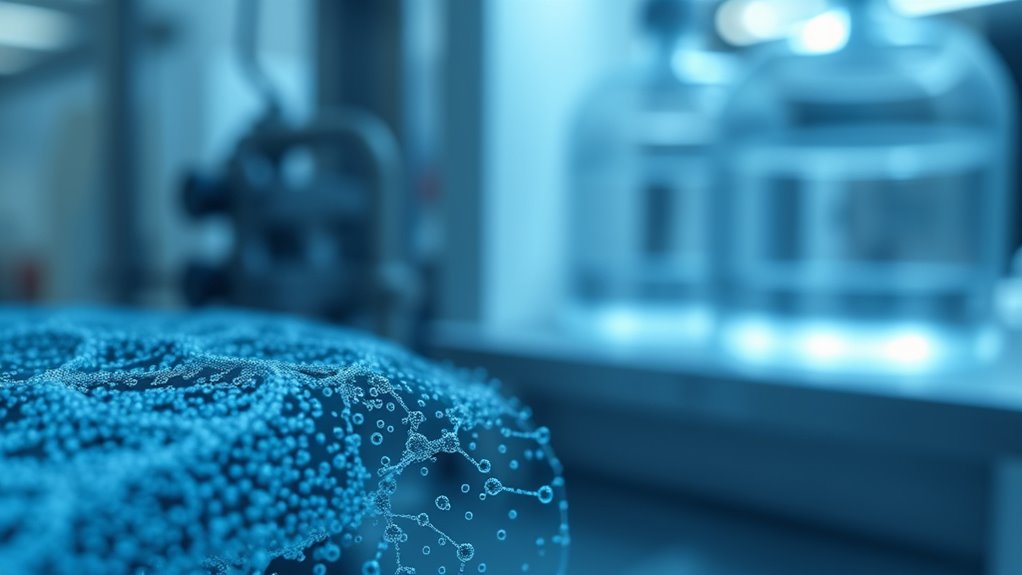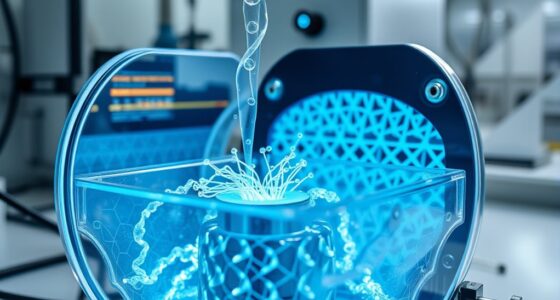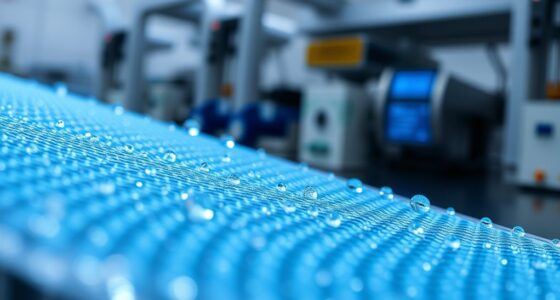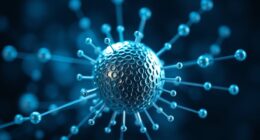Nanotechnology in water purification and desalination uses nanoscale materials and membranes to remove contaminants, pathogens, and salts more efficiently. These advanced solutions feature higher surface areas, improved selectivity, and enhanced durability, making water treatment faster, cheaper, and more sustainable. Innovations like nanostructured membranes, antimicrobial nanoparticles, and nanocomposites help prevent fouling and reduce energy use. To discover how these cutting-edge techniques can transform water management, keep exploring the exciting developments in nanotech for clean water.
Key Takeaways
- Nanotechnology enables the development of advanced filtration membranes with ultra-small pores for highly selective removal of contaminants and pathogens.
- Nanomaterials like graphene oxide and metal-organic frameworks enhance water permeability, durability, and efficiency in purification and desalination processes.
- Incorporating antimicrobial and anti-fouling nanoparticles in membranes reduces biofouling, extends lifespan, and improves overall system performance.
- Nanotechnology-based desalination methods, such as nano-enhanced reverse osmosis, lower energy consumption and improve salt rejection rates.
- Challenges include environmental safety, scalable manufacturing, and regulatory frameworks to ensure sustainable and responsible water treatment applications.
Principles of Nanotechnology in Water Treatment
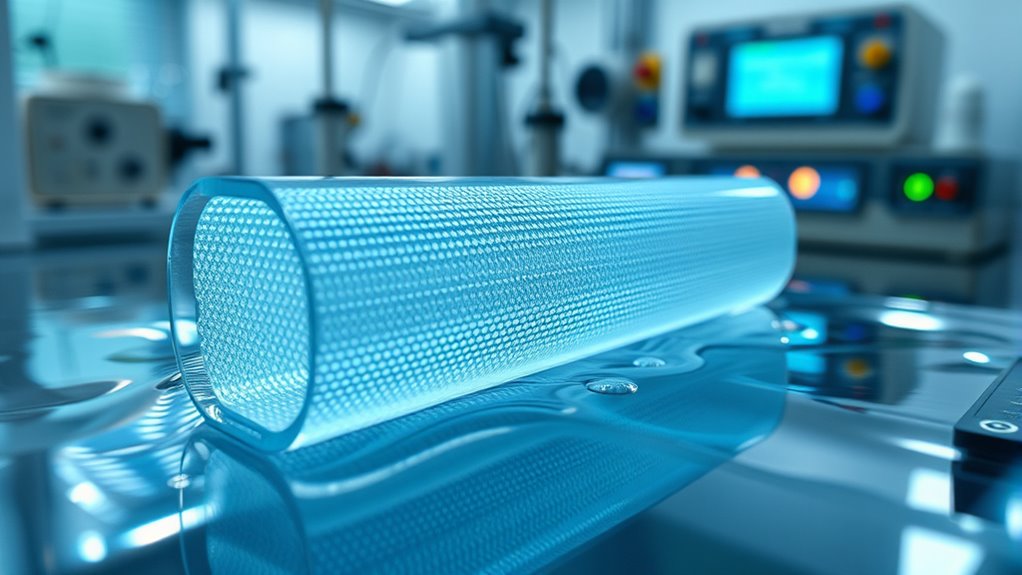
Nanotechnology transforms water treatment by enabling the development of materials and systems at the nanoscale that can effectively remove contaminants. At this scale, materials have unique properties, such as increased surface area and reactivity, which improve their ability to target and eliminate pollutants. Nanoparticles can be engineered to interact specifically with harmful substances, breaking them down or capturing them efficiently. These tiny materials can be incorporated into filters, membranes, and other treatment systems to enhance performance. The principles behind nanotechnology involve manipulating matter at the atomic or molecular level to create innovative solutions. By understanding these principles, you can see how nanotechnology offers precise, effective, and scalable options for improving water quality worldwide. Additionally, the signs of spoilage in liquids help ensure the safe use of water and other beverages in treatment processes.
Advanced Nanomaterials for Filtration

Building on the principles of nanotechnology in water treatment, advanced nanomaterials have revolutionized filtration systems by offering unparalleled efficiency and specificity. These materials, like graphene oxide and metal-organic frameworks, can target contaminants at the molecular level. They increase surface area and porosity, enabling faster filtration and higher contaminant removal rates. You benefit from membranes that are more durable, less prone to fouling, and require less maintenance. These nanomaterials can selectively adsorb or reject pollutants, improving water quality markedly. An understanding of primary sources and peer-reviewed studies ensures accurate and reliable information about these innovations. Here’s a quick comparison:
| Material | Key Benefit |
|---|---|
| Graphene Oxide | High permeability, strong filtration |
| Metal–Organic Frameworks | Customizable pore sizes, high selectivity |
| Carbon Nanotubes | Enhanced mechanical strength, toxin removal |
| Nanowires | Rapid water flow, contaminant detection |
| Nanocomposites | Combination of benefits, durability |
Nanostructured Membranes and Their Benefits
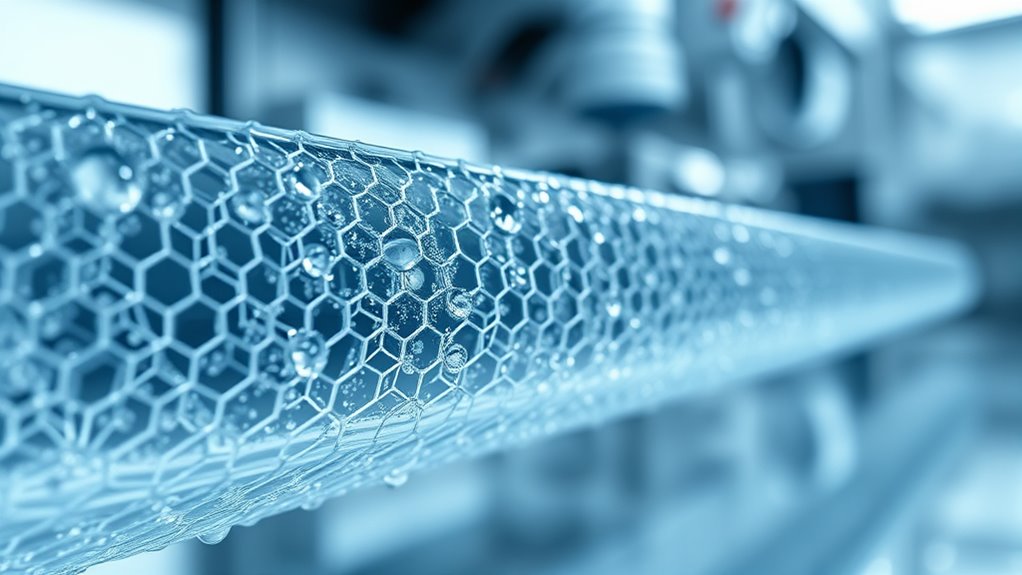
Nanostructured membranes considerably improve filtration efficiency, allowing you to remove contaminants more effectively. They also lower energy use by reducing the pressure needed for water flow, saving you costs. Plus, their anti-fouling properties help keep the membranes cleaner and extend their lifespan. Regular maintenance can further enhance their performance and longevity Eye Patch Benefits.
Enhanced Filtration Efficiency
By incorporating nanostructured membranes, water purification systems can achieve markedly higher filtration efficiency. These membranes feature ultra-small pores, enabling you to remove contaminants more effectively. First, they allow for precise targeting of even the tiniest pollutants, including viruses and heavy metals. Second, their increased surface area enhances flow rates, reducing clogging and maintenance needs. Third, the nanostructure improves selectivity, ensuring only clean water passes through while impurities are blocked. This leads to faster, more reliable filtration without sacrificing quality. As a result, you gain a system that performs better over time, needs fewer replacements, and produces higher purity water. Overall, nanostructured membranes substantially boost filtration efficiency, making water treatment more effective and sustainable.
Reduced Energy Consumption
The increased efficiency of nanostructured membranes not only improves water filtration but also considerably reduces the energy required for the purification process. These membranes achieve this by offering higher permeability, allowing water to pass through more easily while blocking contaminants. Because less pressure is needed to push water through, your energy consumption drops markedly. Nanomaterials create ultra-thin, highly selective barriers that require less force, cutting operational costs and lowering carbon footprints. This means your water treatment system becomes more sustainable and cost-effective over time. Additionally, nanostructured membranes maintain their performance longer, reducing the need for frequent replacements and further saving energy. Overall, adopting nanotechnology in membranes makes water purification more energy-efficient, benefiting both your budget and the environment.
Anti-fouling Properties
Because fouling is a major challenge in water treatment, nanostructured membranes offer a significant advantage by resisting the buildup of contaminants. These membranes have unique surface properties that prevent adhesion of bacteria, algae, and organic matter. This means you’ll experience longer-lasting membranes and reduced maintenance. Here’s how they help:
- Enhanced surface smoothness minimizes sites where foulants can attach.
- Hydrophilic coatings create a water-attracting barrier that discourages foulant attachment.
- Antimicrobial nanoparticles actively kill or inhibit microbial growth, further reducing biofouling.
- The application of nanotechnology in membrane design enables precise control over surface characteristics, boosting anti-fouling performance. Together, these features improve membrane lifespan, lower operational costs, and ensure a more consistent water flow. By adopting nanostructured membranes, you get a more efficient, durable solution that keeps fouling at bay.
Desalination Techniques Enhanced by Nanotech
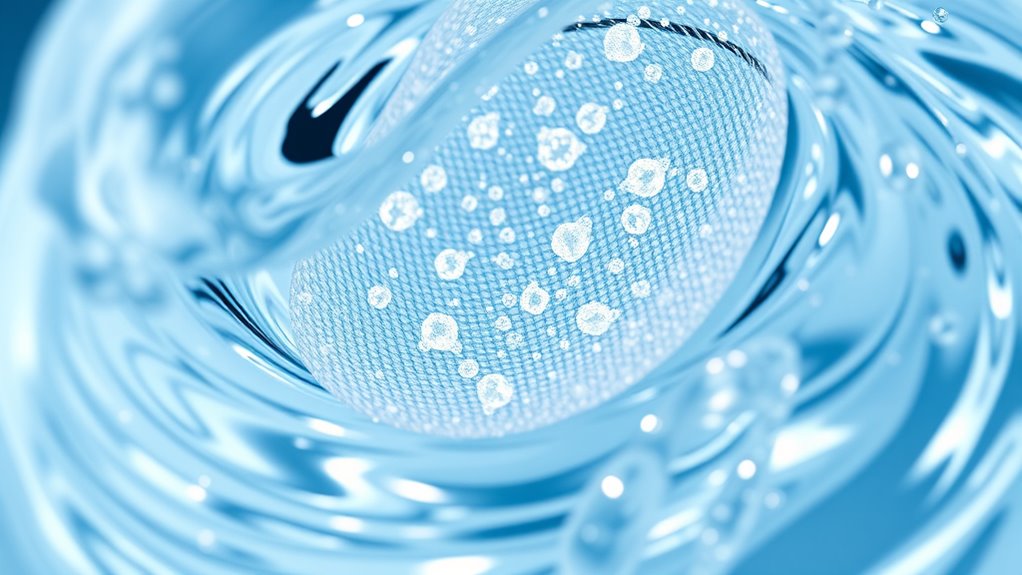
Nanotechnology has revolutionized desalination techniques by providing innovative solutions that markedly improve efficiency and effectiveness. You now benefit from nanomaterials that enhance membrane performance, reducing energy consumption and increasing salt rejection rates. Nanoscale filters and membranes allow faster water flow while blocking contaminants more precisely. For example, nanostructured membranes resist fouling and biofouling, extending their lifespan and reducing maintenance costs. The table below highlights key nanotech-enhanced desalination methods:
| Technique | Benefits |
|---|---|
| Nanocomposite Membranes | Higher permeability, durability |
| Nano-enhanced Reverse Osmosis | Lower energy use, improved salt rejection |
| Nanostructured Filtration | Faster flow, fouling resistance |
| Nano-coatings | Reduced biofouling, longer membrane life |
These advances make desalination more sustainable and accessible. Understanding the benefits of nanotech can further optimize desalination processes and improve overall water treatment efficiency.
Innovations in Nanoparticle-Based Water Purification

Innovations in nanoparticle-based water purification are transforming how we remove contaminants more efficiently. You’ll see how antimicrobial nanoparticles enhance safety, while new solutions lower costs. These advances make clean water more accessible and sustainable for everyone. Additionally, researchers are developing vetted protective measures to ensure the safe application of these nanotechnologies in various environments.
Enhanced Filtration Efficiency
Recent advances in nanoparticle technology have especially boosted the efficiency of water filtration systems. You’ll find that these innovations improve filtration in several ways.
- Nanoparticles increase surface area, allowing filters to trap smaller particles and contaminants more effectively.
- They enhance permeability, enabling water to pass through quickly without sacrificing purity.
- Functionalization of nanoparticles improves selectivity, helping filters target specific pollutants like heavy metals or organic compounds.
These improvements mean you get cleaner water faster and with less energy consumption. The integration of nanoparticles creates filters that are not only more efficient but also longer-lasting. As a result, your water purification process becomes more reliable, cost-effective, and adaptable to various water sources. This leap in filtration technology paves the way for safer, healthier drinking water worldwide.
Antimicrobial Nanoparticles Use
Building on the improved filtration capabilities provided by nanoparticles, researchers are now focusing on their antimicrobial properties to further enhance water purification. These nanoparticles, such as silver, copper, and zinc oxide, can actively kill bacteria, viruses, and other pathogens in water. When integrated into filters or coatings, they provide a rapid, effective way to disinfect water without introducing harmful chemicals. You’ll find these antimicrobial nanoparticles especially useful in remote or disaster-stricken areas where conventional treatment is limited. They work by disrupting microbial cell membranes or generating reactive oxygen species that destroy pathogens. This approach not only improves water safety but also reduces reliance on chemical disinfectants. Additionally, understanding the contrast ratio of filtration devices can help optimize their performance in removing contaminants. As a result, antimicrobial nanoparticles offer a promising, efficient solution for ensuring clean, safe drinking water worldwide.
Cost-Effective Solutions
Cost-effective nanoparticle-based water purification solutions are transforming access to clean water by reducing expenses without compromising effectiveness. These innovations leverage affordable materials and scalable processes to make advanced filtration accessible. For example,
- Researchers develop low-cost nanomaterials from abundant resources like clay or agricultural waste, reducing raw material costs.
- You can implement reusable nanoparticle filters that maintain high performance over extended periods, lowering replacement expenses.
- Combining nanotechnology with existing infrastructure enhances efficiency, decreasing energy consumption and operational costs.
This approach makes water treatment more affordable for communities and industries alike. By focusing on affordable synthesis methods and sustainable materials, you can achieve high-quality purification while keeping costs manageable. These innovations are vital for expanding clean water access worldwide.
Furthermore, AI security technologies can be integrated into water management systems to detect and prevent cyber threats, ensuring the integrity and safety of water infrastructure.
Environmental Impact and Sustainability of Nanotech Solutions
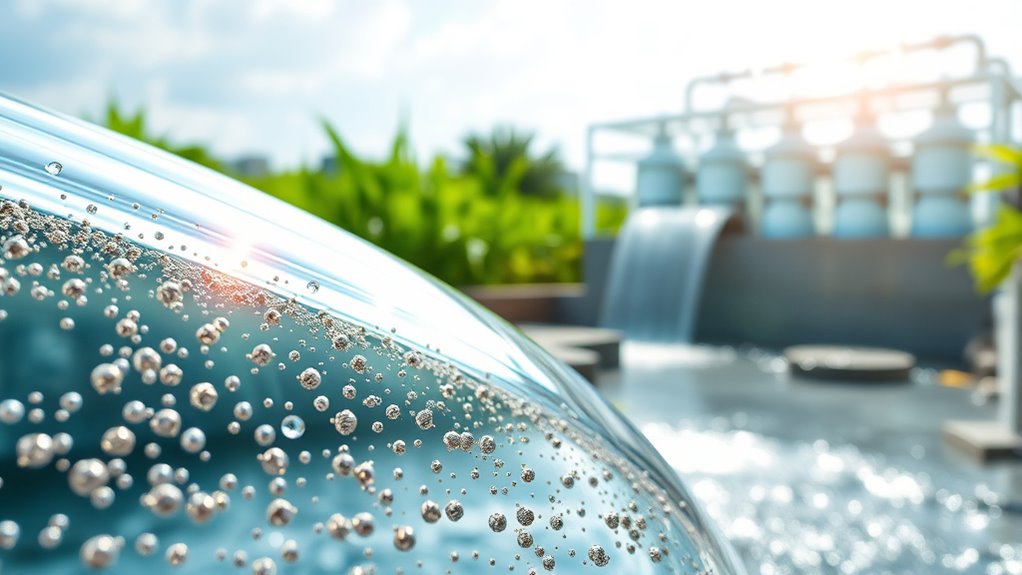
While nanotechnology offers promising solutions for water purification and desalination, it also raises concerns about environmental impacts and sustainability. Nanomaterials may accumulate in ecosystems, potentially harming aquatic life and entering the food chain. Proper disposal and lifecycle management are vital to minimize risks. You should consider the environmental footprint of producing and deploying nanotech devices, ensuring they don’t create more pollution than they solve. Sustainability depends on developing recyclable and eco-friendly nanomaterials. Here’s a quick comparison:
| Aspect | Consideration |
|---|---|
| Environmental Risk | Potential toxicity and bioaccumulation |
| Lifecycle Management | Recycling and safe disposal strategies |
| Sustainability Focus | Developing eco-friendly, recyclable nanomaterials |
Additionally, understanding the regulatory frameworks surrounding nanotech applications can help ensure responsible development and deployment.
Challenges and Limitations in Nanotechnology Applications
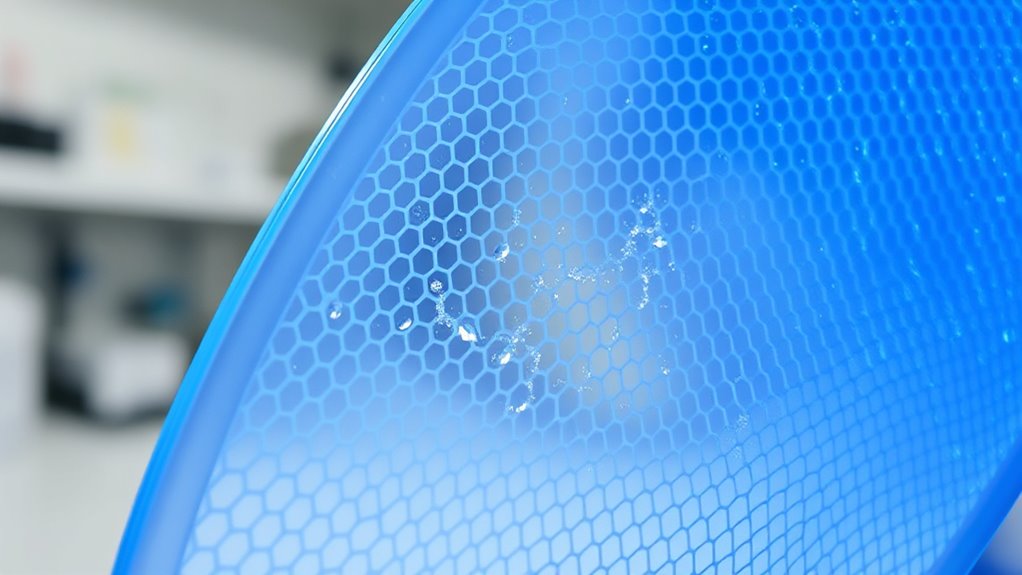
Despite the promising potential of nanotechnology in water treatment, significant challenges hinder its widespread adoption. You face issues like:
- Toxicity concerns: Some nanomaterials may pose health and environmental risks if they leach into water sources, requiring thorough safety assessments.
- Cost barriers: Producing and implementing nanomaterials can be expensive, making large-scale deployment less feasible for many regions.
- Scalability issues: shifting from laboratory success to industrial-scale systems remains complex, often due to difficulties in maintaining consistency and efficiency at larger volumes.
These limitations demand careful research and development efforts to address safety, affordability, and practical application hurdles before nanotech solutions can become mainstream in water purification and desalination.
Future Trends and Emerging Developments
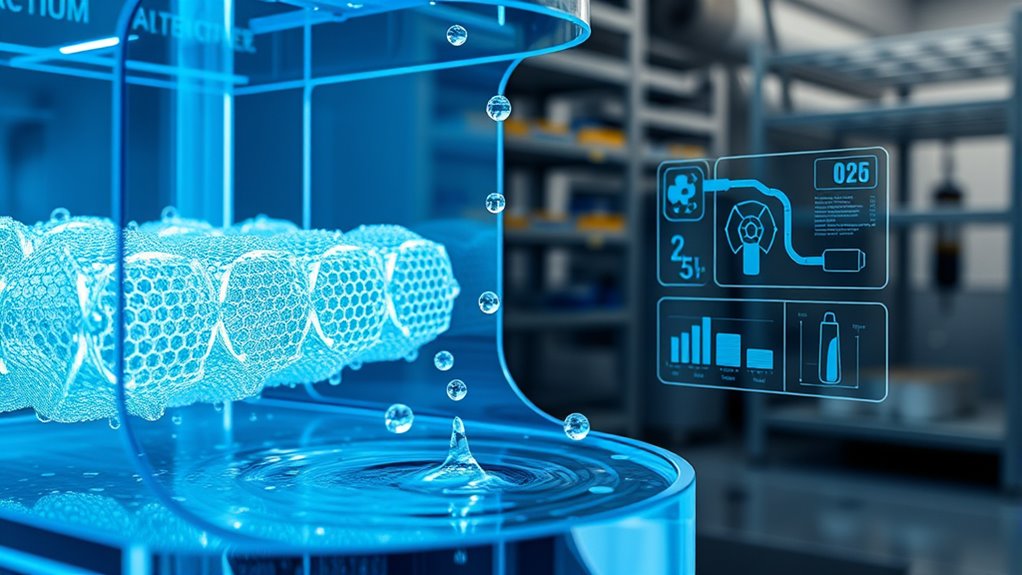
As research advances, emerging trends in nanotechnology aim to overcome current limitations and accelerate its integration into water purification and desalination systems. You can expect smarter, more efficient nanomaterials that target specific contaminants with higher selectivity and lower energy consumption. Researchers are developing multifunctional nanoparticles capable of simultaneous filtration, disinfection, and mineral recovery, streamlining water treatment processes. Innovations like nanostructured membranes are becoming more durable and scalable, reducing costs and improving longevity. Additionally, you’ll see increased focus on eco-friendly synthesis methods and safe disposal practices to address environmental concerns. The integration of nanotechnology with IoT and automation will enable real-time monitoring and adaptive control, making water treatment more responsive and reliable. These advancements promise to make water purification faster, cheaper, and more accessible worldwide. cost‑of‑ownership math
Real-World Implementations and Case Studies

Real-world applications of nanotechnology in water purification demonstrate its practical benefits and ongoing advancements. You’ll find these innovations in diverse settings, from municipal plants to remote communities. For example:
Nanotech in water purification transforms communities with cleaner, more efficient solutions worldwide.
- Nanomembranes in desalination plants improve efficiency and salt rejection, reducing energy costs.
- Silver and copper nanoparticles are incorporated into filters, effectively killing bacteria and viruses.
- Nano-enhanced adsorbents target contaminants like heavy metals and organic pollutants with high selectivity.
These case studies showcase how nanotech solutions deliver cleaner water faster and more sustainably. As you explore further, you’ll see that ongoing research continues to refine these technologies, making them more affordable and scalable. The real-world impact proves nanotechnology’s essential role in addressing global water challenges.
Frequently Asked Questions
What Are the Potential Health Risks of Nanomaterials in Water?
You might be concerned about health risks from nanomaterials in water, such as potential toxicity or environmental impact. If nanomaterials aren’t properly managed, they could enter your body through drinking water, possibly causing cellular damage or other health issues. it is crucial to monitor and regulate their use carefully, ensuring safety measures are in place to minimize exposure and prevent any adverse effects on your health.
How Cost-Effective Are Nanotech-Based Water Purification Systems?
Nanotech-based water purification systems are like a double-edged sword—you get impressive efficiency but at a higher upfront cost. While they can be more cost-effective over time due to reduced chemical use and maintenance, initial investments can be steep, especially in developing regions. You’ll find that their long-term savings and improved water quality often justify the expense, making them a promising, though still evolving, solution for clean water access.
What Regulatory Measures Govern Nanotechnology in Water Treatment?
Regulatory measures for nanotechnology in water treatment vary globally, but you should be conscious of agencies like the EPA in the U.S. and the EMA in Europe, which set safety standards and approval processes. You’re encouraged to comply with these regulations, conduct thorough risk assessments, and follow best practices to guarantee safe implementation. Staying updated on evolving guidelines helps protect public health and the environment while leveraging nanotech innovations effectively.
Can Nanomaterials Be Recycled or Reused After Water Treatment?
Did you know that over 90% of nanomaterials used in water treatment can be reclaimed or reused? Yes, you can recover nanomaterials after treatment, often through filtration or magnetic separation, reducing waste and costs. Proper management ensures they maintain effectiveness and safety. Recycling nanomaterials not only supports sustainable practices but also minimizes environmental impact, making water purification more efficient and eco-friendly.
How Scalable Are Nanotech Solutions for Large-Scale Water Desalination Projects?
Nanotech solutions are increasingly scalable for large-scale desalination projects, thanks to advances in manufacturing and material efficiency. You can implement these technologies in existing infrastructure or develop new plants that harness nanomaterials’ unique properties. While challenges remain, such as cost and material durability, ongoing research aims to optimize scalability. With proper investment and innovation, you’ll find nanotech solutions becoming more practical and accessible for widespread water desalination efforts.
Conclusion
While nanotechnology offers promising avenues for water purification and desalination, it gently invites you to contemplate the delicate balance between innovation and environmental stewardship. As you explore these advancements, remember that each breakthrough carries the potential for both progress and unforeseen challenges. Embracing responsible development ensures that these cutting-edge solutions can quietly shape a more sustainable future, allowing you to navigate the path forward with mindful optimism and respect for our planet’s intricate harmony.
